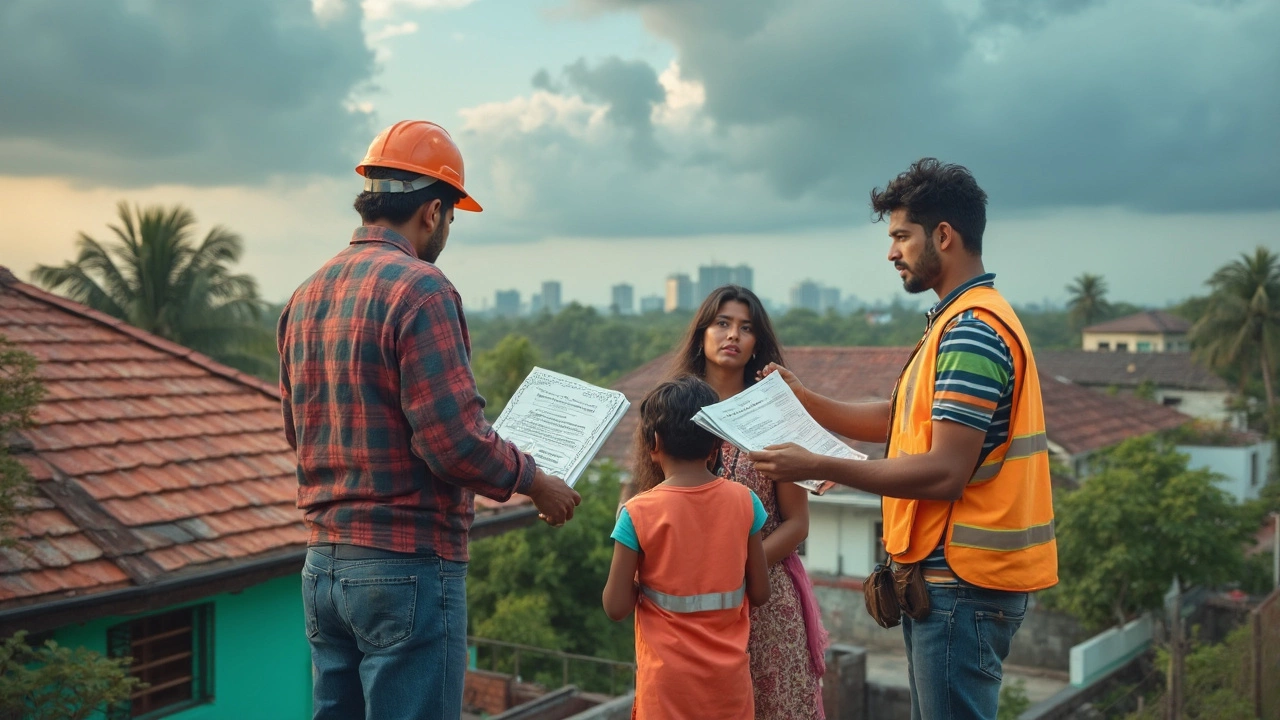If someone just mentioned "roof payment" and you went blank, you're not the only one. The term sounds simple, but it can mean a few things and has some tricky details. Basically, when you hire a roofer, a roof payment is the money you owe for their work—whether that's for a repair, regular maintenance, or a total roof replacement. Knowing how and when to pay makes a huge difference in avoiding headaches later.
Most roofers don’t expect to get paid all at once. In fact, if they do, that’s a red flag. The usual process means splitting the payment into parts—like a deposit up front, another chunk once they drop off materials, and the rest when you’re happy with the finished roof. This spread-out schedule protects both sides and sets clear expectations.
There’s something else to know: the payment methods and timing can change depending on the job size, local laws, and your agreement with the roofer. For big jobs, you might see contracts that spell things out in detail. For a quick patch, it could be as simple as handing over a check or paying online after the work's done. It’s all about knowing what’s normal so you don’t get caught off guard or scammed.
- What Does a Roof Payment Actually Mean?
- Standard Ways Roofers Accept Payment
- Payment Schedules: What's Normal?
- Avoiding Payment Pitfalls and Scams
- Insurance, Loans, and Financing Options
- Pro Tips for Managing Roof Payments
What Does a Roof Payment Actually Mean?
When people talk about a roof payment, they’re just talking about money you pay to a contractor for roofing work—nothing more complicated than that. But how you pay, what gets paid for, and when you hand over that cash or transfer matters a lot. Usually, you’re not just paying for shingles or nails. You’re paying for labor, hauling away old materials, warranties, and sometimes permits or inspections, depending on your local codes.
Think of a roof payment as a bundle that covers:
- The cost of materials (like shingles, underlayment, flashing)
- Labor to tear off the old roof and install the new one
- Cleanup and disposal of old roofing
- Any warranty or guarantee the roofer provides
- Extras—maybe new gutters, deck repairs, or code upgrades
For simple repairs, you might only pay once—job done, roof fixed, money handed over. But if you’re replacing a whole roof, expect more steps. Most reputable companies use contracts that lay out the total roof payment, how much to pay up front, and exact timing for follow-ups. Some states even limit how big a deposit a roofer can ask for; in California, for example, a contractor can’t ask for more than 10% of the total or $1,000, whichever is less.
Here’s a quick look at what usually goes into the cost:
| Typical Cost Breakdown | Percentage of Total |
|---|---|
| Materials | 40-50% |
| Labor | 40-50% |
| Permits/Disposal/Other | 5-15% |
So your roof payment isn’t just about the visible stuff on top of your house—it covers a lot more. Don’t forget, if you’re working with an insurance claim or getting a home improvement loan, your payment plan might have to fit with your lender’s or insurer’s rules, too.
Standard Ways Roofers Accept Payment
Roofer payment methods aren’t exactly mysterious, but it’s easy to assume everyone takes cards or just cash. That’s not always the case. Most reputable roofing contractors will offer a few practical payment options. Picking the right one just makes life easier—for them and for you.
The most common ways to make a roof payment include:
- Checks: Still super popular, especially when you want a record of your payment. You usually make checks out to the company, not the individual worker.
- Electronic bank transfers (ACH): For bigger jobs, this is fast and makes it easy to trace payments. Some roofers even provide their account info on the contract for this.
- Credit cards: Not every company offers this, but it’s picking up steam, especially for larger companies. Just double-check—some charge extra fees for processing.
- Cash: Some small roofing crews may accept cash for minor repairs. But here’s a warning: you should always get a written receipt for any cash payments. No paper trail means no proof if something goes wrong.
- Mobile payment apps: Apps like PayPal, Zelle, or Venmo are starting to show up in the industry for quick, smaller jobs. Handy, but verify the app is linked to the company—not some random personal account.
Roofers are getting more tech-savvy. According to a 2023 industry study, about 48% of larger U.S. roofing companies now accept electronic payments, and that number’s growing.
| Payment Method | Paper Trail | Fees |
|---|---|---|
| Check | Yes | Usually none |
| Bank Transfer | Yes | Low/None |
| Credit Card | Yes | Possible 2-3% |
| Cash | Receipts needed | None |
| Mobile Apps | Depends | Sometimes |
One last thing for roofing services payments: never pay everything up front, no matter how popular the payment method is. Real pros will spell out clear terms so you’re both protected.
Payment Schedules: What's Normal?
If you’ve never hired a roofer, it might surprise you that nobody expects you to hand over all the cash on day one. A typical roof payment schedule is set up to make things run smoothly for both you and the contractor. This is how you make sure work gets done, materials show up, and nobody runs off with your money.
Most reputable roofing companies break payments into chunks:
- Deposit Upfront: The first payment covers materials and secures your spot on the schedule. It’s usually between 10% and 30% of the total price. Watch out if a roofer asks for more than 50% upfront—big deposits are risky.
- Materials Delivery: Once the shingles and other supplies are on site, you might pay another 30% or so. This step shows your roofer is serious and keeps work moving.
- Final Payment: The rest is due when the work’s all finished and you’ve had a chance to check everything out. Never pay the full amount until the job is done and you’re satisfied.
Some states have laws on what contractors can ask for upfront. For example, in California, contractors can’t take more than 10% or $1,000 (whichever is less) as a deposit before work starts. It’s smart to check what’s normal in your state so you don’t get scammed.
If you’re working with an insurance claim, the roof payment schedule might change. Usually, the insurance company pays you in installments—first when the job starts, then after work is verified. And if you’re using a home improvement loan, your lender might want proof of progress before releasing each chunk of cash. It keeps everyone honest.
Here’s a quick look at what most homeowners experience on a standard roof replacement:
| Payment Stage | Typical % of Total Cost | When It's Due |
|---|---|---|
| Deposit | 10%-30% | At contract signing |
| Materials Delivery | 30%-40% | When materials arrive on site |
| Final Payment | 30%-60% | After work is finished and inspected |
Just remember: don’t let go of all your money until you know the work’s done right. Payment schedules protect both you and the roofer, so don’t be afraid to set clear milestones before you sign anything.

Avoiding Payment Pitfalls and Scams
Not all roofing contractors play by the rules, so it pays—literally—to know what red flags look like. One of the top ways people get burned is by handing over most or all of the roof payment before the work starts. Real talk: a trustworthy roofer usually asks for a deposit, but it's almost never more than one-third of the total job cost. If someone asks for half or the full price up front, something's off.
According to the Better Business Bureau, roofing scam reports spike after hail storms and hurricanes, especially when out-of-town crews rush in. The most common tricks? High-pressure sales, super lowball estimates, and then disappearing after you pay that big deposit. It's no accident. These scammers want easy targets, and confused homeowners make it easy for them.
Staying safe isn't that hard if you stick to some basics:
- Get a written contract that shows all costs, payment stages, and what work gets done at each step. If a roofer balks at paperwork, walk away.
- Never pay in cash. Stick to checks or credit cards so you have a payment record.
- Ask for proof of insurance and licenses. No shame in double-checking with your local licensing office.
- Don’t let anyone start work until you’ve seen materials delivered to your home. It’s a good way to know things are really happening.
- Be careful with door-to-door "roof inspectors" who say you need work right after a storm. If it sounds urgent and you feel rushed, it’s usually a scam.
Here's a quick breakdown of what’s typical for a roof payment schedule based on real industry data:
| Stage | Payment Percent |
|---|---|
| Deposit | 10% - 33% |
| Materials Delivered | 30% - 40% |
| Completion | Rest of balance |
Sticking to normal payment milestones keeps you in control and makes it way harder for scammers to disappear with your money. Set reminders for each stage, and don’t hand over any final roof payment until you’ve done a walkthrough and checked that all work matches your contract. If something seems sketchy, trust your gut and don’t be afraid to slow down the deal. That little pause can save you thousands in lost money and headaches.
Insurance, Loans, and Financing Options
Before you swipe your credit card or write a huge check, take a step back and look at all the ways to handle your roof payment. Sometimes, you won’t have to pay for everything out of your own pocket—especially if insurance, loans, or flexible financing is on the table.
If your roof was damaged by something like a hailstorm, falling trees, or heavy winds, home insurance might cover some or even all costs. File a claim ASAP and snap clear photos of the damage. Then, call your insurance company and follow their process. If your claim gets approved, the insurer usually pays in two parts: one after the claim is approved, and the rest once the work is done and inspected.
If insurance won’t chip in (say, for a worn-out roof or one past its prime), you’ve got other options. Personal loans from a bank or credit union are straightforward, but compare rates to avoid burning cash on interest. Some folks use home equity loans or lines of credit—these are worth considering if you’ve got good equity, but remember your house is on the line if payments go south. Credit cards can work for smaller jobs, but high interest can sneak up fast.
Now, a lot of roofers make it easier for homeowners by offering in-house financing or working with third-party lenders. This can mean:
- Low or no interest for the first year
- Monthly payment plans spread out over several months or years
- Quick approval with minimal paperwork
Always read the fine print. Some payment plans come with hidden fees or jump up in interest after a promo period ends.
| Option | Pros | Cons |
|---|---|---|
| Insurance | Can cover most costs if damage is from a covered event | Lengthy approval process, lots of paperwork |
| Personal Loan | Lump sum, fixed rates | Payments add up if rate is high |
| Home Equity | Lower interest, larger amounts possible | Risking your house as collateral |
| In-House/Third-Party Financing | Easy to set up with your roofer, good for those without strong credit | Possible higher interest or fees |
Don’t forget to ask your roofer what roof payment support they offer. Most are used to working with insurance, loans, or their own payment plans, and want to help you protect your home without blowing up your budget.
Pro Tips for Managing Roof Payments
Paying for your new roof sounds straightforward, but a couple of smart moves can save you cash and headaches later. Most people don’t realize how much flexibility they have—if you talk things through and ask the right questions, you’re more likely to get what you want and avoid bad surprises.
First off, always get your payment schedule in writing. Verbal agreements can turn into a game of "he said, she said." Your contract should clearly spell out every payment stage, from the initial deposit (usually 10%-30% of the total roof payment) to final payment only after you’re satisfied. If a roofer pushes for more than a third upfront, that’s often a sign to walk away.
Not sure about the right payment stages? Here’s the play-by-play a legit roofing company will usually offer:
- Deposit (10-30% to get you on the schedule and cover initial materials)
- Second payment after materials arrive or partway through the job
- Final payment only after you check the finished work
Always use traceable payment methods. Checks or credit cards make a clear paper trail; cash can disappear fast, and some shady contractors use that to their advantage. Most legit roofers these days offer digital options like ACH transfer or payment portals too.
Worried about getting stuck with a half-finished or badly-done job? Check if your roofer is licensed, insured, and well-reviewed online before you hand over money. Insist they show you proof, not just a business card. About 60% of roofing scams start with fly-by-night contractors who ask for full payment right away—then vanish or deliver shoddy work. Don’t be a statistic.
Also, ask about the warranty. You want it written, not just promised. Many solid roofers offer a 5-10 year warranty on workmanship. Save all your receipts and paperwork somewhere safe—in case you need proof for a roof payment insurance claim down the road.
If your cash is tight, talk about financing before you sign anything. Some roofers partner with lenders to offer monthly plans or even 0% short-term options if your credit’s decent. Bringing this up early means you don’t get stuck stressing over how to come up with the full payment on the spot.
| Payment Stage | Average % Paid | Pro Tip |
|---|---|---|
| Deposit | 10-30% | Never pay more than 30% up front |
| Mid-Project | 30-40% | Pay only after materials are delivered |
| Completion | 30-60% | Pay the rest after final walk-through |
Bottom line: Trust your gut and stick to these tips to make the whole roof payment process smooth and safe. A reliable roofing company will respect these steps—and probably expect you to ask about them too.






